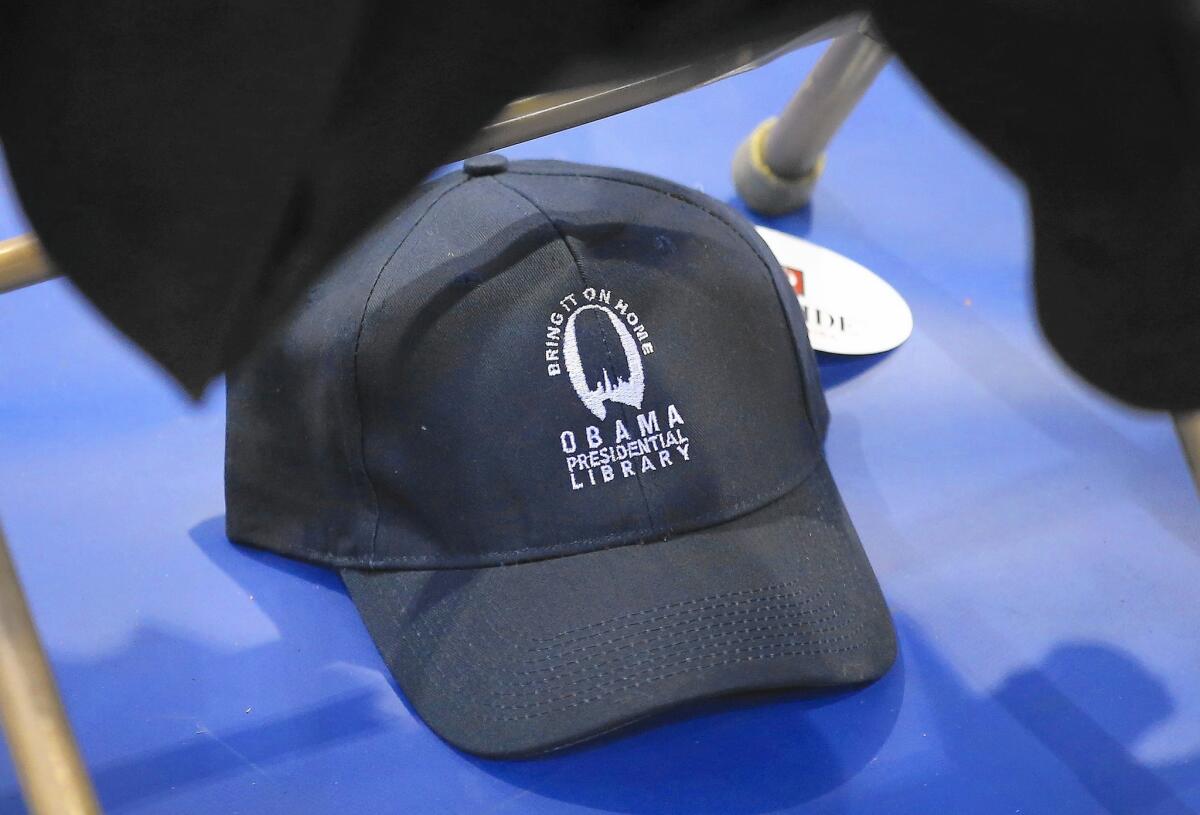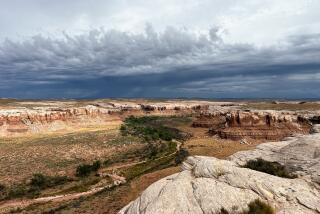Chicago land feud over Obama presidential library plan reflects familiar history

- Share via
Reporting from CHICAGO — With President Obama expected to choose the site for his library in coming months, Chicagoans have been engaged in a bitter fight over a proposal to place it in a public park. But this is not the first time a presidential library has been at the center of a land dispute.
In College Station, Texas, residents fought Texas A&M University over plans to move a pig farm to make way for the George H.W. Bush Presidential Library and Museum.
Residents in Atlanta tied themselves to trees and lay down in front of bulldozers to stop the city from building a highway through a public park leading to President Carter’s library.
And in Little Rock, Ark., the city evoked eminent domain to make way for President Clinton’s library.
Last month, the Chicago Parks District board voted to transfer roughly 20 acres of parkland to the city if the University of Chicago was chosen to host the Obama library, a move the library’s foundation said “improves Chicago’s bids” for the facility.
The plan has pitted preservationists who oppose the land transfer plan against community residents who support it as a means of economic development. The university’s proposal is to build the library in either Washington Park or Jackson Park.
The dispute has placed the school in a controversial light and given steam to what it considers its biggest rival for the library, Columbia University in New York. The University of Illinois at Chicago remains in the running, as does the University of Hawaii.
The parkland debate is the latest in a long and complicated history of land fights involving presidential libraries, said Benjamin Hufbauer, associate professor of art history at the University of Louisville and author of “Presidential Temples: How Memorials and Libraries Shape Public Memory.”
In most cases, presidents have sat on the sidelines while others battled it out on their behalf. But the presidents almost always have the final say on whether to continue the fight or throw in the towel. “In general, presidents don’t want controversy. It doesn’t help them,” Hufbauer said.
Even before George W. Bush announced his selection of Southern Methodist University for his library, the school had been caught up in a dispute with its neighbors.
For years, Southern Methodist had been buying land surrounding the Dallas campus. Though the university had kept details of its library bid under wraps, some residents of a nearby condominium complex suspected that the school was attempting to buy up the complex, unit by unit, to build the library there. Most sold their condos willingly, but not Gary Vodicka, who battled the university in court for four years.
In the end, the city seized the land on behalf of the university through eminent domain, and the 347-unit complex was razed. The land is now is part of the grounds of the George W. Bush Presidential Center.
In Little Rock, officials battled over the definition of a park. The city’s plans to build the Clinton library in a decaying warehouse district on the edge of downtown sparked a court battle that lasted nearly five years.
Landowner Gene Pfeifer refused to give up his 3-acre riverfront property in the middle of the proposed library site. In the end, the state Supreme Court allowed the city to acquire the property through eminent domain.
“In the traditional sense, we didn’t displace any houses. But we did displace homeless people in a way that I regret to this day,” said James “Skip” Rutherford, who headed Clinton’s foundation during the construction and is now dean of the University of Arkansas Clinton School of Public Service in Little Rock. “I wish I had toured some of those vacant warehouses before we tore them down.”
When President Carter was about to build his library in the 1980s, a controversy developed over a decades-old plan to cut a roadway through Olmsted Linear Park in Atlanta. The two-lane highway, then called “Presidential Parkway,” would encircle the Carter library, which sat atop the hill where Union Gen. William Sherman watched Atlanta burn during the Civil War.
Though the park was littered and barely used, residents from affluent neighborhoods nearby, calling themselves “roadbusters,” organized protests to stop construction. In one incident, a woman who had climbed a dogwood tree fell to the ground as city workers sawed it down. After the case was in the courts for more than 12 years, the road was built but cut off before entering the park.
“The original plan would have completely ruined the park,” said Jennifer Richardson, an Atlanta resident who participated in the protests.
When President Reagan announced plans in 1983 to build his library at Stanford University, officials boasted that he would be the first president to open his library while still in the White House.
But residents of Palo Alto didn’t like the idea of a presidential library because of the increased traffic and environmental concerns. Students and faculty at Stanford argued that the library would become an unwanted conservative think tank in the center of the campus. So they joined forces to make sure it didn’t happen.
In 1987, Reagan abandoned the plan and went looking for a site that was more welcoming. He found one in Simi Valley, but even then there were fights over increased traffic, air quality, future development and even a rare sunflower that grew on the hilltop where the library would be built. It finally opened in 1991.
More to Read
Sign up for Essential California
The most important California stories and recommendations in your inbox every morning.
You may occasionally receive promotional content from the Los Angeles Times.










